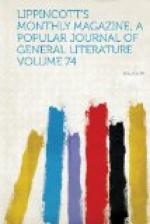THE NEW HYPERION.
From Paris to Marly by way of the Rhine.
III.—The feast of saint athanasius.
[Illustration: The PAULISTS.]
As I parted from my stout old friend Joliet, I saw him turn to empty the last half of our bottle into the glasses of a couple of tired soldiers who were sucking their pipes on a bench. And again the old proverb of Aretino came into my head: “Truly all courtesy and good manners come from taverns.” I grasped my botany-box and pursued my promenade toward Noisy.
The village of Noisy has made (without a pun) some noise in history. One of its ancient lords, Enguerrand de Marigny, was the inventor of the famous gibbet of Montfaucon, and in the poetic justice which should ever govern such cases he came to be hung on his own gallows. He was convicted of manifold extortions, and launched by the common executioner into that eternity whither he could carry none of his ill-gotten gains with him. Here, at least, we succeed in meeting a guillotine which catches its maker. By a singular coincidence another lord of Noisy, Cardinal Balue, underwent a long detention in an iron-barred cage—one of those famous cages, so much favored by Louis XI., of which the cardinal, as we learn from the records of the time, had the patent-right for invention, or at least improvement. Once firmly engaged in his own torture—while his friend Haraucourt, bishop of Verdun, experienced alike penalty in a similar box, and the foxy old king paced his narrow oratory in the Bastile tower overhead—we may be sure that Balue gave his inventive mind no more to the task of fortifying his cages, but rather to that of opening them.
[Illustration: The reward of an inventor.]
These ugly reminiscences were not so much the cause of a prejudice I took against Noisy, as caused by it. At Noisy I was in the full domain of my ancient foe the railway, where two lines of the Eastern road separate—the Ligne de Meaux and the Ligne de Mulhouse. The sight of the unhappy second-class passengers powdered with dust, and of the frantic nurses who had mistaken their line, and who madly endeavored to leap across to the other train, stirred all my bile. It was on this current of thought that the nobleman who had been hung and the cardinal who had pined in a cage were borne upon my memory. “Small choice,” said I, “whether the bars are perpendicular or horizontal. You lose your independence about equally by either monopoly.”
[Illustration: Cardinal Balue.]
I crossed the Canal de l’Ourcq, and watched it stretching like a steel tape to meet the Canal Saint—Denis and the Canal Saint-Martin in the great basin at La Villette—a construction which, finished in 1809, was the making of La Villette as a commercial and industrial entrepot. I meant to walk to Bondy, and after a botanic stroll in its beautiful forest to retrace my steps, gaining Marly next day by Baubigny, Aubervilliers and Nanterre. “The Aladdins of our time,” I said as I leaned over the soft gray water, “are the engineers. They rub their theodolites, and there springs up, not a palace, but a town.”




